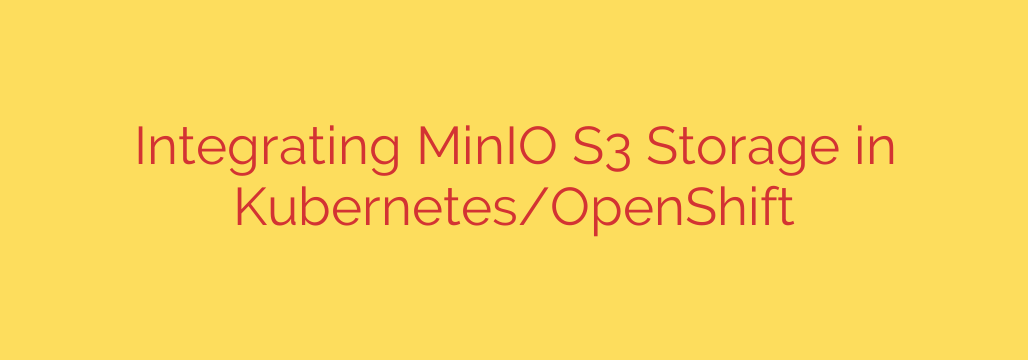
Unlocking Persistent Storage: A Guide to Integrating MinIO S3 in Kubernetes and OpenShift
Managing data for stateful applications in containerized environments like Kubernetes and OpenShift presents a significant challenge. While ephemeral storage works for stateless services, applications that require data persistence—such as databases, machine learning pipelines, and content management systems—need a robust and scalable storage solution. This is where MinIO, a high-performance, S3-compatible object storage server, becomes an essential tool in your cloud-native stack.
By integrating MinIO directly into your Kubernetes or OpenShift cluster, you can build a powerful, private, and highly available storage layer that seamlessly serves your applications. This guide explores why MinIO is an excellent choice for containerized environments and provides a clear path for its deployment and configuration.
Why Choose MinIO for Your Kubernetes Cluster?
Before diving into the technical details, it’s important to understand the strategic advantages of using MinIO. It’s more than just a storage server; it’s a solution designed for the demands of modern, cloud-native architectures.
- Complete S3 API Compatibility: MinIO implements the Amazon S3 API, which has become the de facto standard for object storage. This means any application, tool, or library built to work with AWS S3 can be pointed to your MinIO instance with minimal to no code changes. This ensures broad compatibility and simplifies integration.
- Exceptional Performance: Designed from the ground up for performance, MinIO excels at handling large-scale data workloads. It’s optimized for high-throughput and low-latency operations, making it ideal for data-intensive tasks like big data analytics, AI/ML model training, and large-scale backups.
- Cloud-Native Architecture: MinIO is built for environments like Kubernetes. It can be easily deployed, scaled, and managed using standard container orchestration tools. Its ability to run on commodity hardware makes it a highly cost-effective alternative to public cloud storage solutions.
- Scalability and Resilience: You can run MinIO in a distributed mode across multiple nodes, providing both high availability and massive scalability. If a node fails, your data remains accessible, ensuring the resilience your production applications demand.
Deploying MinIO in Kubernetes Using a Helm Chart
The most efficient and recommended method for deploying MinIO on Kubernetes is by using its official Helm chart. Helm simplifies the process by packaging all the necessary Kubernetes resources—like Deployments, Services, and PersistentVolumeClaims—into a single, configurable package.
Prerequisites:
- A running Kubernetes or OpenShift cluster.
kubectloroccommand-line tool configured to connect to your cluster.- Helm 3 installed on your local machine.
Step 1: Add the MinIO Helm Repository
First, you need to add the official MinIO repository to your Helm configuration so you can access its charts.
helm repo add minio https://charts.min.io/
helm repo update
Step 2: Install the MinIO Chart
With the repository added, you can now install MinIO. During installation, you must define your access credentials. It is critical to set your own secure accessKey and secretKey instead of using defaults.
Here is a basic command to deploy a standalone MinIO instance:
helm install minio-release minio/minio \
--set accessKey=YOUR_ACCESS_KEY \
--set secretKey=YOUR_SECRET_KEY
Replace YOUR_ACCESS_KEY and YOUR_SECRET_KEY with strong, unique credentials. For a production environment, you should consider deploying MinIO in its distributed mode for high availability.
Step 3: Verify the Deployment
After running the install command, Helm will create the necessary resources. You can verify that the MinIO pod is running correctly with the following command:
kubectl get pods -l release=minio-release
You should see a pod with a name like minio-release-... in the Running state.
Accessing and Using Your MinIO Instance
Once MinIO is deployed, you need a way to connect to it, both for administrative tasks and for your applications.
1. Accessing the MinIO UI for Administration
The simplest way to access the MinIO web interface is by using kubectl port-forward. This command forwards traffic from your local machine to the MinIO service inside the cluster.
kubectl port-forward svc/minio-release 9000:9000
Now, you can open your web browser and navigate to http://127.0.0.1:9000. Log in with the accessKey and secretKey you configured during installation. From here, you can create buckets, manage user policies, and monitor your storage.
2. Connecting Applications Within the Cluster
For your applications running inside the same Kubernetes cluster, connecting to MinIO is straightforward. You can use the internal Kubernetes DNS service name. The service name is typically in the format <release-name>.<namespace>.svc.cluster.local.
For example, if you installed MinIO with the name minio-release in the default namespace, the endpoint URL for your S3 client would be: http://minio-release.default.svc.cluster.local:9000.
Your application would then use this endpoint along with the stored access and secret keys to interact with the MinIO server.
Essential Security Best Practices
Running a storage service requires a strong focus on security. Here are some actionable tips for securing your MinIO deployment in Kubernetes:
- Manage Credentials with Kubernetes Secrets: Never hardcode your
accessKeyandsecretKeydirectly in your Helm command or application code. Instead, leverage Kubernetes Secrets to store these credentials and mount them securely into your application pods. - Implement Network Policies: Use Kubernetes
NetworkPolicyresources to restrict traffic to your MinIO instance. You can create rules that only allow pods with specific labels (e.g., your application pods) to communicate with the MinIO service, effectively creating a firewall within your cluster. - Enable Transport Layer Security (TLS): For production workloads, always enable TLS to encrypt data in transit between your applications and the MinIO server. The MinIO Helm chart includes configuration options for automatically provisioning and managing TLS certificates.
- Use IAM Policies for Granular Control: Within MinIO, create user policies that follow the principle of least privilege. For example, if an application only needs to read objects from a specific bucket, create a read-only policy for that bucket and assign it to the user credentials the application uses.
By integrating MinIO into your Kubernetes or OpenShift environment, you gain a powerful, scalable, and cost-effective object storage solution that empowers your stateful applications. Following these deployment steps and security best practices will ensure your data is not only accessible and performant but also secure.
Source: https://kifarunix.com/integrate-minio-s3-storage-with-kubernetes-openshift/







